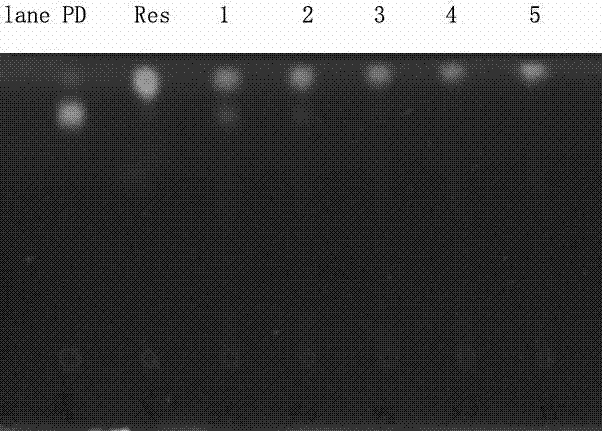Method for converting polydatin to resveratrol by microbial enzyme method
A technology of resveratrol glycosides and resveratrol, applied in the field of extraction and transformation of natural active substances
- Summary
- Abstract
- Description
- Claims
- Application Information
AI Technical Summary
Problems solved by technology
Method used
Image
Examples
Embodiment 1
[0025] Example 1, the acquisition of microbial strains that efficiently transform polydatin into resveratrol:
[0026]Collect wild Polygonum cuspidatum samples from various places, use Polygonum cuspidatum extract to prepare different culture media, screen endophytic bacteria from Polygonum cuspidatum, rinse freshly collected rhizomes of Polygonum cuspidatum under tap water, drain the water, and cut into 2~ For the 3 cm section, perform the following surface disinfection treatment according to conventional aseptic procedures: rinse with 75% alcohol for 3-5 s, rinse with 0.1% mercury liter for 4-5 min, and rinse with sterile water for 4-5 times. Peel off the above-mentioned treated rhizomes under aseptic conditions to take the phloem, cut off the periphery of the phloem, and then cut into small pieces of 0.5 cm × 0.5 cm, and place them on PDA plates. Place 4 pieces on each plate. After incubating at 30°C for 3-7 days, fungal hyphae grew from the cut edge of the sample. After pu...
Embodiment 2
[0027] Embodiment 2, Aspergillus aculeatus ( Aspergillus.aculeatus ) Morphological characteristics of CGMCC No.3876:
[0028] strain Aspergillus aculeatus ( Aspergillus.aculeatus ), CGMCC No.3876 was cultured in PDA medium for 3 to 4 days, and its morphological characteristics were observed with an optical microscope. The mycelium of this strain was colorless, light-colored, or colored substances were aggregated on the surface, and there was a septum. Conidiophores grow vertically from mycelial cells with thick walls and enlarged, most of them have no septum, smooth or rough, the upper part is thicker, and the top expands into spherical, oval, semicircular or club-shaped vesicles; from the vesicles The entire surface of the vesicles produces stalks radially or only at the top of the vesicle; the stalks are single-layered or branched into 2 to more stalks at the top. The conidia are born in clusters on the top of the small stalks, arranged radially or clustered into columns...
Embodiment 3
[0029] Embodiment 3, Aspergillus aculeatus ( Aspergillus.aculeatus ) Fermentation preparation of extracellular enzymes of CGMCC No.3876:
[0030] Prepare medium (formula 4% bran, 1.0% peptone, initial pH 5.0), inoculate Aspergillus aculeatus CGMCC No.3876, and ferment aerobically in a 100 L fermenter at 28-30°C for 3.5 days, and ferment one layer The gauze solution was filtered and centrifuged at 5000 rpm in a three-legged centrifuge for 20 minutes. The supernatant was concentrated 5 times with a hollow fiber membrane with a molecular weight cut-off of 5000 Da. The concentrated solution was 12 L of extracellular enzyme crude enzyme solution compound enzyme; The cellulase activity of bacterial strain, xylanase activity, β-glucosidase activity, the cellulase filter paper enzyme activity (Filter Paper Activity, FPA) of this bacterial strain fermented liquid reaches 3.8 IU / mL (wherein, one FPA enzyme activity International unit refers to the amount of enzyme that generates 1.0 μ...
PUM
 Login to View More
Login to View More Abstract
Description
Claims
Application Information
 Login to View More
Login to View More - R&D
- Intellectual Property
- Life Sciences
- Materials
- Tech Scout
- Unparalleled Data Quality
- Higher Quality Content
- 60% Fewer Hallucinations
Browse by: Latest US Patents, China's latest patents, Technical Efficacy Thesaurus, Application Domain, Technology Topic, Popular Technical Reports.
© 2025 PatSnap. All rights reserved.Legal|Privacy policy|Modern Slavery Act Transparency Statement|Sitemap|About US| Contact US: help@patsnap.com

